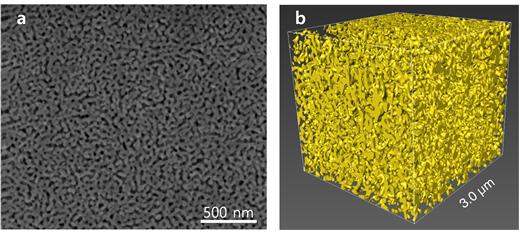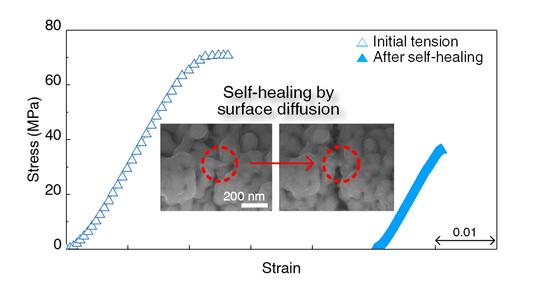A research team, led by Professor Ju-Young Kim in the Department of Materials Science and Engineering at UNIST has reported the self-healing ability of nanoporous gold (np-Au) with nanoscale ligaments under ambient conditions. The research team solved the shortcomings of porous materials that are brittle in nature and could easily break at strains by reducing the pore size of the resulting np-Au.
The greater the number of pores present inside the material, the larger the surface area becomes. Nanoporous gold (np-Au), as the name implies, also contains fine pores on the order of a few nanometers to a few hundreds of nanometers in size. Due to the large surface area of np-Au and lightweight, np-Au has many applications, such as electrode materials, sensors, and catalysts. Not only that, they also exhibit attractive properties such as remarkable catalytic activity and excellent biocompatibility, and thus could potentially be used in biomedical devices. However, their fragile nature hinders significantly their widespread application.

To surmount the limitations of fragile np-Au, the research team has reduced the size of pores of np-Au, as small as 25 μm. In general, the decrease in strength is caused by an increase in porosity. However, the newly-developed material has a higher strength even with small pores. Besides, the self-healing ability of np-Au in terms of mechanical properties shows strength recovery up to 64.4% and fully recovered elastic modulus compared with initial tensile properties.
In further experiments, the research team discovered Topological parameters obtained by three-dimensional reconstruction of self-healed np-Au clarify the strength, elastic modulus, and strain distribution. Besides, they also found that the self-healing process in np-Au is attributed to surface diffusion expedited by local compressive stress in the ultrasmall dimension of ligaments formed by ductile failures of individual ligaments.

The resulting material integrates the advantages of both porous materials and gold. The pore space occupies 70% of the total volume, and thus are lightweight. Besides, the surface area of the new material is 100,000 times greater than the area of the gold. In addition, it has high electrical conductivity and excellent chemical stability, thus showing excellent biocompatibility.
"This research provides the first experimental observation of np-Au's self-healing ability and offers the possibility of bottom-up synthesis for reusable nanomaterials," says Professor Kim. "This research is also significant in terms of being able to recycle damaged gold."
The findings of this research have been published in the online version of Nano Letters on August 14, 2020. This study has been supported by the National Research Foundation of Korea (NRF) and the POSCO Science Fellowship of POSCO TJ Park Foundation.
Journal Reference
Eun-Ji Gwak, Hansol Jeon, Eunji Song, and Ju-Young Kim, "Self-Healing of Nanoporous Gold Under Ambient Conditions," Nano Letters, (2020).






